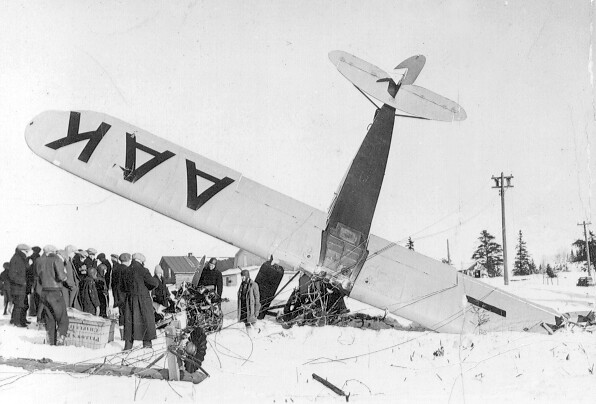

The first aircraft crash in Chapleau, Tuesday, December 12, 1933. It occured at the corner of Cherry and Connought Streets, being blown over a house at the lakefront. This was a Fairchild 71 owned by Canadian Airways and piloted by Ron George. It was based at Chapleau during the Swayze gold rush. There were two passengers in the ship, Elmer Fraser and Len Perfetto, neither being injured. The pilot had a slight cut over one eye. The engine was completely severed from the craft by a guy wire from a hydro pole. The broken pole may be seen in the foreground. The shearing of the engine from the fuselage was so complete that the two were a few feet apart. (the foregoing is what Mr. Crichton wrote about this incident).
Note the fellow in leather flying gear looking at the engine. You can make out one propeller blade. Note also the wooden crate, upside down in the snow with Pellow's Chapleau written on it and the snapped hydro pole with the street light still attached. Here is the second photo, showing the smashed front of the machine. Note the Canadian Airways logo on the side of the airplane.
The Toronto Daily Star reported the next day, December 13, 1933 as follows. THREE INJURED WHEN AEROPLANE CRASHES NEAR CHAPLEAU. When the aeroplane flown by Ron George, northern air pilot, crashed into a rocky hill, near Chapleau, Ont., three men, Len Perfetto, W. McDonald and Fritz Fraser were slightly injured. George, who figured in a landing with a broken ski some months ago, again saved his passengers by skillful handling. The 7-passenger machine in taking off was struck by a cross-wind.
Another newspaper clipping in the posession of Bud Park of Chapleau, probably from the Sudbury Star, reported the event this way under the picture of the plane: AFTER THE PLANE CRASH AT CHAPLEAU Three men were injured, none seriously, when an aeroplane crashed at Chapleau on Tuesday. The aeroplane was in charge of Ron George, noted northern air pilot, who probably saved the lives of the passengers by his skillful landing under difficult conditions. The wrecked aeroplane is shown above. The crash occured right after the take-off when a cross-wind struck the aeroplane.